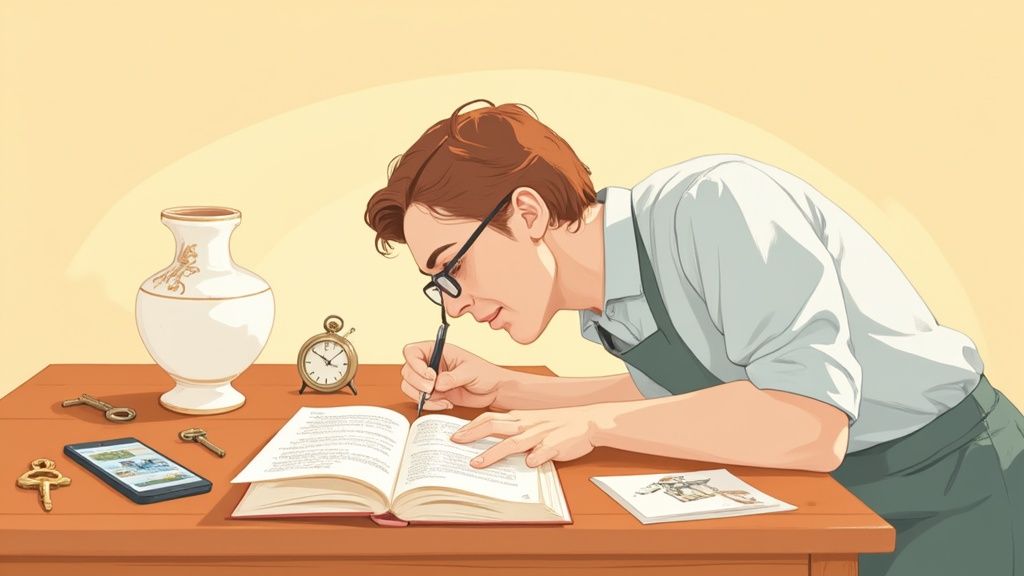Figuring out what an antique is actually worth goes far beyond just checking its age. To get to a real market value, you need to dig into its rarity, condition, and history. It's a fascinating blend of detective work and market research that turns a dusty old object into something with a documented story and a price tag to match.
Decoding What Makes an Antique Valuable
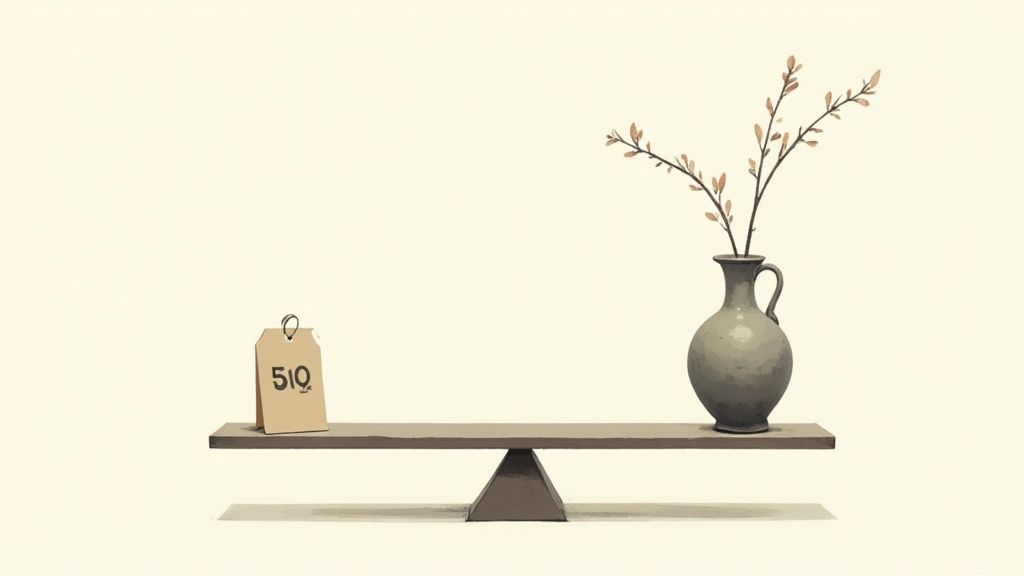
Ever found yourself staring at a forgotten piece in an attic or a flea market, wondering if it's a hidden treasure? The reality is, many items hold more value than you'd think, but it's rarely because they're simply old. Learning to value an antique is like learning a new language—one spoken through subtle clues like maker's marks, the quality of craftsmanship, and the stories of its past owners.
Think of this guide as your first real lesson in that language. We're going to break down the core principles that professional appraisers rely on every day. Soon, you'll start seeing these items through a much more informed, critical eye. It’s not just about spotting something old; it’s about understanding why it's valuable.
The Key Factors Driving an Item's Worth
At the heart of any solid valuation, a few key elements always come into play. Get a handle on these, and you'll have a strong foundation for assessing almost any piece that crosses your path.
- Rarity: This is basic supply and demand. How many were made? How many are left? A piece that was mass-produced, even if it's over 100 years old, will almost always be less valuable than a limited-run item from the same period.
- Condition: We're talking about more than just a few scratches. Look for original parts, untouched finishes, and no major repairs. While a little wear can add character (what collectors call "patina"), significant damage or a clumsy restoration can tank an item's value.
- Provenance: This is the item's life story, its documented history. Proof linking an item to a famous person, a historical event, or a renowned maker can send its value soaring. A simple desk becomes a historical artifact if you can prove it once belonged to a well-known author.
- Aesthetics and Desirability: Tastes change, and trends matter. A piece might be rare and in mint condition, but if it doesn't fit with what collectors are buying right now, its value might be lower than you'd expect. On the flip side, a sudden surge in popularity for a style like Mid-Century Modern can drive prices way up.
Expert Insight: An antique's value is never about just one thing. It's the unique blend of its scarcity, physical state, historical journey, and current market demand that ultimately determines its true worth.
Core Factors Influencing Antique Value
Here’s a quick-reference table to help you run through the key attributes that shape an antique's market value. Use it to make a fast initial assessment of any item you're looking at.
| Valuation Factor | What It Means for Your Item | Potential Impact on Value |
|---|---|---|
| Rarity | Is it one-of-a-kind or one of thousands? | High rarity can dramatically increase value. |
| Condition | Are there chips, cracks, or repairs? Is it all original? | Mint condition commands top dollar; damage lowers it. |
| Provenance | Can you trace its ownership history? | A documented link to someone or someplace famous adds significant value. |
| Desirability | Is this style or maker currently in high demand? | Trendy items sell faster and for higher prices. |
Getting a feel for these factors is the first step toward a confident and accurate valuation.
Looking at the Bigger Picture
It’s also smart to remember that the antiques market is a living, breathing part of a much larger economy. The collectibles industry as a whole was recently valued at around USD 58.4 billion. Interestingly, the mid-price segment—items valued between USD 50 and USD 500—claims nearly half of that market. This "sweet spot" is where many collectors and casual buyers feel comfortable, finding a great balance between affordability and unique appeal.
Having this foundational knowledge is a game-changer. By learning to assess these core factors, you’re moving past guesswork and starting to apply the same logic as the experts. For an even deeper look, our guide on how to find the value of antiques breaks down the process even further.
Your Hands-On Item Examination Process
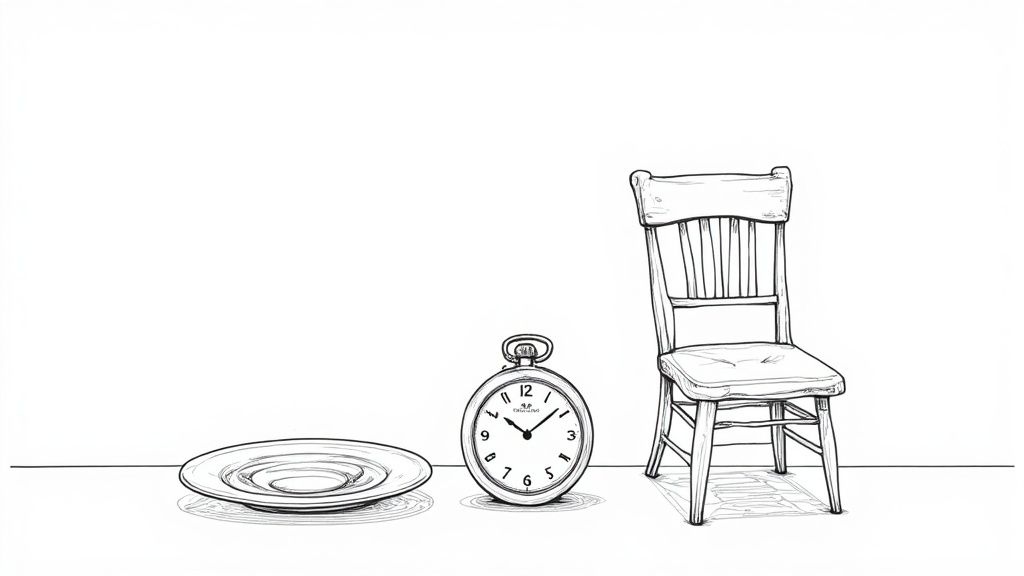
Alright, this is where the fun really starts. We've talked about the theory; now it's time to roll up your sleeves and become a detective. Getting to know your piece intimately is the foundation of any good appraisal, and it all begins with a careful, hands-on look.
First things first, set up your workspace. You’ll want a well-lit area, and nothing beats natural daylight for seeing true colors and subtle details. Harsh lamps can cast weird shadows and hide what you need to see. Grab a simple magnifying glass and a soft, clean cloth. That's all you need.
The Hunt for Maker's Marks and Signatures
For me, this is the most exciting part—the search for a maker’s mark, a signature, or a symbol. These are the breadcrumbs that lead you straight to the who, when, and where of your item. They can be incredibly elusive, so don't just check the obvious spots.
Carefully turn the piece over and inspect the base, the back, and any hidden nooks. On ceramics and porcelain, the mark is almost always on the unglazed bottom. For furniture, you might find a stamp inside a drawer, on a back panel, or even burned into the wood. We talk a lot more about furniture-specific clues, like dovetail joints, in our guide to identifying antique furniture.
A word of caution: handle with care. An old paper label can turn to dust with one wrong move, and you can easily rub away a faint ink signature if you’re too aggressive. Always use a soft, dry brush to clear away grime, never a wet cloth.
My Two Cents: Finding a maker's mark is often the single biggest breakthrough you can have. It turns an anonymous object into something with a story and a known origin—a game-changer for valuation.
Getting Brutally Honest About Condition
Condition is everything in the antiques trade. You have to learn to be an impartial judge and see the item for what it is, flaws and all. I always create a detailed "condition report" for my records. It helps me stay objective and view the piece through the eyes of a potential buyer.
Start with a general once-over, then get granular. Go over every single inch.
- Surface-Level Flaws: Make a note of every chip, crack, scratch, or stain. Is that a faint hairline in the glaze or a serious fracture that goes all the way through?
- Repairs and Restorations: Be on the lookout for tell-tale signs of a fix. Look for modern screws, mismatched paint, or the tell-tale shimmer of glue under the light. A good, professional repair is one thing, but an untouched original is almost always the holy grail.
- Patina vs. Damage: There's a huge difference between the two. The gentle wear on a wooden chair arm from a century of use is called patina, and it adds character and value. A big, fresh chip from being dropped last week is just damage.
- Original Parts: Does it have all its original components? A grandfather clock with its original pendulum and weights is worth a great deal more than one pieced together with replacements.
For every issue you find, ask yourself: how much does this really affect the piece? A tiny chip on the foot of a vase is far less of a problem than one right on the rim.
Taking Photos That Tell the Whole Story
Good photos are non-negotiable, especially if you plan on selling online or getting an expert opinion. You don't need a fancy camera—your phone is fine—but your technique makes all the difference.
Here’s a simple shot list I follow to make sure I don't miss anything:
- The 360-Degree View: Get clear shots of all sides, plus the top and bottom. A plain background, like a white wall or a sheet, makes the item pop.
- The Close-Ups: This is where you zoom in on the good stuff. Capture every maker's mark, signature, or beautiful detail like a carving or piece of hardware.
- The Flaws: Yes, photograph the damage! Be transparent. Document every chip, crack, or old repair you found. It builds immense trust with appraisers and buyers.
- The Sense of Scale: In at least one photo, place a familiar object like a coin or a ruler next to the item. It instantly gives a clear idea of its size.
Once you’ve completed this hands-on examination, your item is no longer just a thing—it’s a documented piece with a story. Armed with your detailed notes and sharp photos, you're ready for the next step: diving into the market research.
Mastering Your Research and Market Analysis
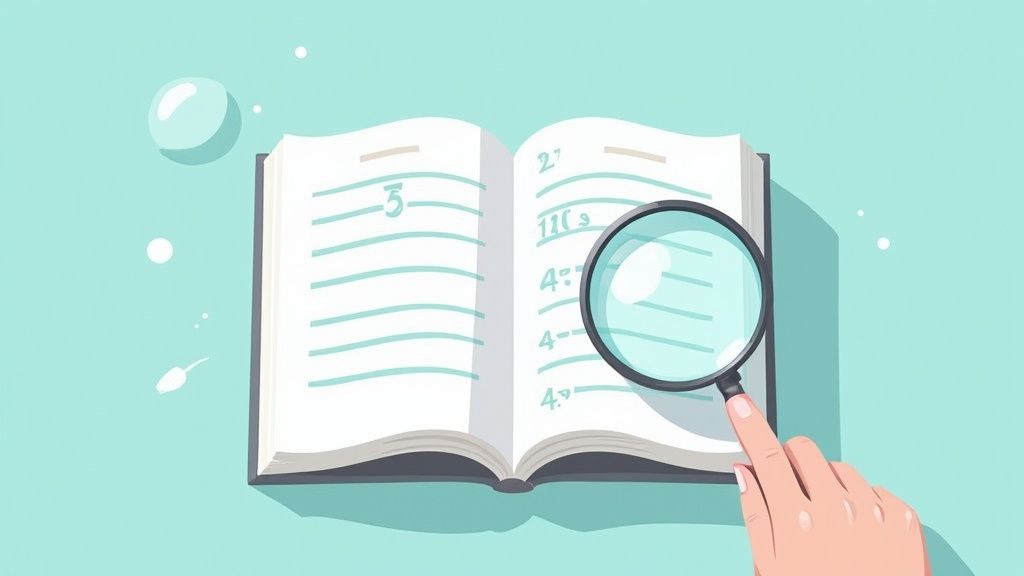
Alright, you've done the initial legwork. You have your notes, your photos are sharp, and now it's time to play detective. This is where we connect the physical details of your item to its actual value out in the real world. We're going hunting for "comps"—or comparable sales—to see what similar pieces have recently sold for.
Forget about what you think it might be worth. A credible valuation is built on a foundation of solid evidence. Your job isn't to pinpoint one magic number, but to establish a realistic price range backed by multiple sources. This is how you confidently shift from "I think..." to "The market shows..."
Where to Look First: Your Research Arenas
I've learned over the years that it's best to cast a wide net first, then slowly narrow your focus. You'll want to start with the big online marketplaces before diving into the more specialized resources.
Here are my go-to spots for digging up comps:
- Broad Marketplaces: Sites like eBay and Etsy are absolute goldmines for data. The key is to use their "sold listings" filter. This shows you what people actually paid, not just what sellers are asking for. It's a critical distinction.
- Specialized Auction Sites: For higher-end items, I immediately turn to platforms like LiveAuctioneers or Invaluable. These sites aggregate results from hundreds of real-world auction houses, giving you a powerful look into the upper tiers of the market.
- Collector Forums and Groups: Never underestimate the power of a niche community. If you have, say, a specific type of vintage watch or a piece of Art Deco pottery, there's likely a forum full of experts who live and breathe this stuff. They often share recent sales data and invaluable market insights.
A Quick Tip on Searching: Get creative with your keywords. Start with the obvious, like "1920s Tiffany-style table lamp," but don't stop there. Broaden your search to include variations like "Art Nouveau bronze slag glass lamp" or just the maker's name if you managed to find one. The more angles you try, the more comps you'll uncover.
Making Sense of the Data You Find
Finding a list of sold items is just step one. The real skill is in interpreting what those prices actually mean. A price isn't just a number; it's the final sentence in a story. You have to understand the context behind each sale to know if it's a truly relevant comparison for your piece.
For instance, a fully restored Morris Chair that sold at a prestigious Chicago auction will command a very different price than the exact same model, in original but worn condition, sold out of a barn in rural Vermont. Both are valid data points, but they represent opposite ends of the market spectrum.
The surge in online selling has a huge impact here. The global online art and antiques market has blown past USD 10 billion in total transaction value. And even while the overall global art market saw a slight dip to USD 65 billion in 2023, the number of online transactions actually jumped by 4%. This tells us more items are being sold online, often at more accessible prices, making digital comps more crucial than ever. It's worth a moment to dive deeper into the global art market trends to see how this shift might affect your item's value.
Retail vs. Auction: What's the Difference?
Understanding the distinction between a retail price and an auction price is fundamental. Getting this right will save you from setting wildly unrealistic expectations.
| Price Type | What It Represents | Key Considerations |
|---|---|---|
| Retail Price | The price tag you'd see in an antique shop or gallery. It includes the dealer's overhead, expertise, and profit margin. | This is the highest market value, often 2-3 times what the dealer originally paid. Think of it as an "insurance value" or a top-end benchmark. |
| Auction Price | The "hammer price" an item hits on a specific day. It's a direct measure of what at least two bidders were willing to pay. | This is considered the true "fair market value," but it can be volatile. The price is influenced by the heat of the moment, the number of bidders, and the auction house's reach. |
Here's a simple way to think about it: the auction price is what a dealer might pay for an item. The retail price is what that dealer would then sell it for. When pricing your own piece for sale, your realistic number will almost always land somewhere between the wholesale (auction) value and the full retail price. The more effort you're willing to put into finding the right buyer, the closer you'll get to that retail figure.
The Power of Provenance and Market Trends
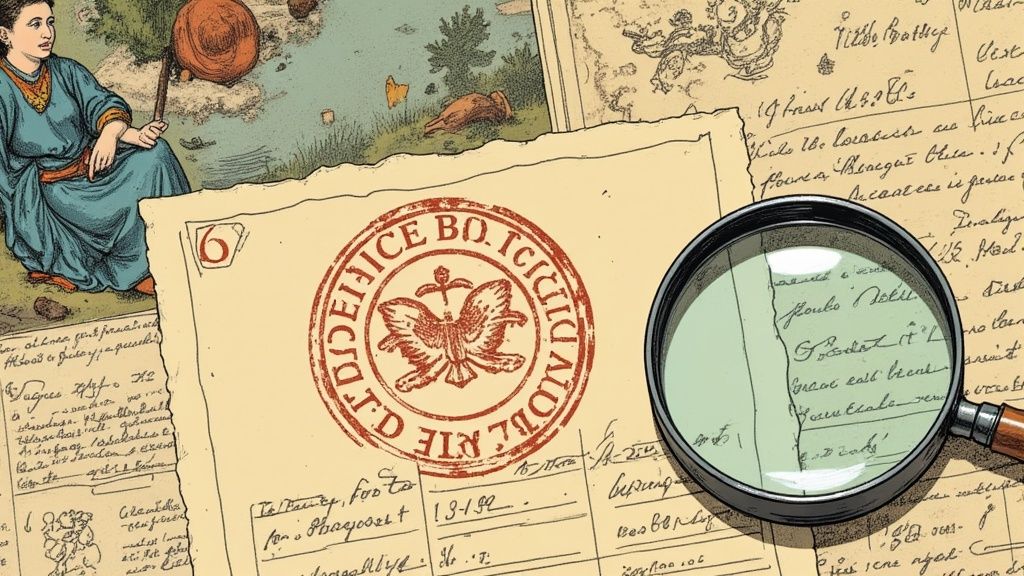
If an antique’s condition and maker’s marks are its body, then its provenance is its soul. Provenance is the story behind the piece—its documented chain of custody from the moment it was made to the day it landed in your hands. It’s the very thing that can elevate a beautiful but common object into a priceless treasure.
Imagine you have two seemingly identical 18th-century writing desks. One was pulled from an old farmhouse, its history completely unknown. The other, however, comes with a faded letter from the original owner, a receipt from a 1920s estate auction, and a photograph of it sitting in a well-known family's library.
The second desk is no longer just furniture. It’s a tangible piece of history, and its value will be exponentially higher because of it. This is why provenance is a cornerstone of any serious appraisal; it provides the rich context and ironclad authenticity that seasoned collectors and museums fight for.
Tracing Your Item's Backstory
So, where do you even start when trying to uncover an item's past? It takes a bit of detective work, but the payoff can be enormous. Your goal is to find any scrap of paper, any inscription, or any family tale that connects your item to a specific person, place, or moment in time.
Kick off your investigation with the obvious:
- Family Heirlooms: If the piece came down through your family, talk to everyone. Record every story, no matter how trivial it seems. A simple clue like, "Grandma said she got this from her aunt in Boston," can be a powerful breadcrumb trail.
- Original Receipts and Documents: Dig through old files and drawers. Old sales receipts, letters mentioning a purchase, or even the original box are the absolute gold standard for establishing provenance.
- Inscriptions and Labels: Carefully inspect the item for names, dates, or addresses engraved directly onto it or written on old, forgotten labels. A previous owner's name is a fantastic clue that can lead you to genealogical records or local historical archives.
Think about it: a plain silver locket is one thing. But a locket inscribed with initials and a date? Now you have something to go on. You can jump onto ancestry websites or contact historical societies to see if you can link those details to a real person.
Expert Takeaway: Never, ever dismiss the paperwork. I've seen a dusty, folded-up receipt in a drawer turn out to be more valuable than the antique it described. That piece of paper is the verifiable proof that separates an item from being merely "old" to being "historically significant."
How Geography and Trends Shape Value
An antique's value isn't a fixed number; it's heavily swayed by regional tastes and what's currently "hot" in the market. What sells for a premium in one city might be completely overlooked in another. This is where a real understanding of market dynamics is absolutely essential.
A classic example is early American furniture. A beautifully crafted piece of early 19th-century Shaker furniture would almost certainly command a top price at an auction in New England, where its history is deeply rooted and appreciated. That same piece might struggle to find an enthusiastic buyer in the Pacific Northwest, where styles like Mid-Century Modern or Arts and Crafts are in much higher demand.
Likewise, global markets have their own appetites. North America and Europe are still the giants of the antique trade, and their established auction houses and expert networks have a huge say in pricing and demand worldwide. The projected growth in these markets just reinforces how important they are. If you want to dive deeper, you can explore more on the antique market's regional dynamics to see how these trends play out.
Knowing this helps you position your item for the best possible outcome. If you're selling a piece of vibrant Texan folk art, marketing it to collectors in the American Southwest is just common sense. Trying to sell it in Paris would be an uphill battle. Recognizing these geographical nuances is a key skill; your item's story includes where it will be valued most.
When to Call in a Professional Appraiser
Doing your own homework with a tool like Curio is fantastic. It's empowering, and for most situations—like pricing a piece for a yard sale or satisfying your own curiosity—it’s all you need. But there are times when a casual estimate just won't cut it.
Some high-stakes scenarios demand the formal, legally-binding opinion of a certified professional appraiser. Knowing when to make that call is a critical skill for any collector. A professional appraisal isn't just a number; it's a meticulously researched document that holds up in court and with insurance companies. It's your safety net when things get serious.
The Non-Negotiables: When a Formal Appraisal is Required
Certain life events and financial dealings are simply too important to leave to an informal valuation. Trying to use a self-researched price in these situations can lead to serious legal headaches, financial loss, or finding yourself underinsured when you need it most. It's the difference between a handshake deal and an iron-clad contract.
You should absolutely hire a certified appraiser for any of these situations:
- Insurance Coverage: To properly insure a valuable piece, you need an appraisal that establishes its Replacement Value. This is the document your insurance company will demand to create the policy and, more importantly, to process a claim if the item is lost, stolen, or damaged.
- Estate Settlements: When dividing assets among heirs, a Fair Market Value appraisal is essential. It ensures everyone is treated equitably, satisfies probate court requirements, and prevents the kind of family disputes that can last for generations.
- Charitable Donations: Thinking of donating a significant antique to a museum or charity? If you want to claim a tax deduction, the IRS will require a formal appraisal from a qualified professional to substantiate the item's worth.
- Divorce Proceedings: Much like an estate settlement, a formal appraisal provides a neutral, unbiased valuation that's crucial for the fair division of marital assets.
Key Takeaway: The reason you need an appraisal determines the type of value you need. An online estimate is perfect for a flea market negotiation, but it carries zero weight with the IRS or a judge.
It's Not Just One Number: Understanding Different Appraisal Types
Here’s something many people don’t realize: not all appraisals are the same. The value of your antique can shift dramatically depending on the context. You can’t just walk in and ask an appraiser for "the value." You need to be specific about what you need the report for.
| Appraisal Type | What It Really Means | When You'd Use It |
|---|---|---|
| Fair Market Value (FMV) | The price a willing buyer would pay a willing seller on the open market. Think of this as a realistic auction or private sale price. | Estate settlements, equitable distribution, and most tax purposes. |
| Replacement Value | The cost to replace an item with a similar one, usually purchased at a retail price. This is almost always a higher number than FMV. | Strictly for insurance. This is what it would cost to buy a comparable piece today. |
| Liquidation Value | The "fire sale" price. It's what an item would likely fetch if the seller had to sell it immediately. | Bankruptcy or other forced-sale situations. This is typically the lowest valuation. |
Asking for the right type of appraisal from the get-go is critical. A mismatch between the report and its intended purpose can render the entire document useless.
How to Find and Vet an Appraiser You Can Trust
Finding the right appraiser is just as important as deciding you need one in the first place. You’re not just buying a number; you’re investing in expertise, ethics, and a solid reputation.
A great place to start your search is with the major professional organizations. These groups hold their members to strict ethical codes and require ongoing education to stay certified:
- Appraisers Association of America (AAA)
- International Society of Appraisers (ISA)
- American Society of Appraisers (ASA)
Once you have a few names, don’t be shy about interviewing them. A true professional will be happy to discuss their qualifications and process. Ask about their direct experience with items like yours, how they structure their fees, and what the final report will include. A huge red flag is any appraiser who charges a percentage of the item's value—that's a major conflict of interest.
Finally, get the cost in writing upfront. Fees for professional appraisals can vary widely, so it's smart to know what you're getting into. For a deeper dive into what to expect, our guide covering the costs of antique appraisals can help you budget for this important investment. Finding the right professional is a partnership that gives you the confidence that your treasures are valued correctly and ethically.
Common Questions About Valuing Antiques
Even with the best roadmap, valuing antiques can feel like navigating a maze. It’s completely normal to hit a snag or second-guess a detail. Think of this as a quick-reference guide for those nagging questions that pop up for everyone, from seasoned collectors to curious beginners.
Let’s clear up some of the most common hurdles so you can move forward with confidence and make solid, informed decisions about your items.
Is My Item an Antique or Just Old?
This is probably the most common question out there, and the answer is more specific than you might think. For an item to officially be called an antique, it needs to be at least 100 years old. Things that are younger but still have a bit of age to them fit into different buckets.
- Vintage: This usually refers to items between 20 and 99 years old. A funky shag rug from the 1970s or a sleek Mid-Century Modern credenza from 1955 are classic examples of vintage.
- Collectible: This one is all about demand, not age. A rare, limited-edition action figure from the 1990s can be highly collectible even though it’s not old enough to be vintage.
The 100-year rule isn't just a casual guideline; it's the standard used by customs for import and export, making it the industry benchmark. Using the right term is your first step toward getting more accurate research results.
How Much Does a Small Flaw Affect the Value?
The truth is, it depends entirely on how bad the damage is and where it is. A tiny chip on the unglazed bottom of a ceramic vase—something you'd never see on display—might only knock the value down by 5-10%. But move that exact same chip to the rim where it’s impossible to miss, and you could see the value plummet by 30-50%, or even more.
Think about it this way: Imagine a beautiful Victorian walnut dresser. A few light surface scratches are part of its story, its "patina," and might not hurt the value one bit. But if one of its original, intricately carved drawer pulls was replaced with a generic modern knob? That’s a major hit to its authenticity and value.
The real question to ask is: does the flaw mess with the item’s structure or ruin its look? Hairline cracks, sloppy old repairs, and missing original parts will almost always hurt the value far more than a bit of honest wear and tear from a long life.
I Can't Find an Exact Match Online. What Now?
Don't panic! It’s actually incredibly rare to find an identical twin to your item with a perfect sales record attached. The goal of your research isn't to find an exact match but to build a strong case for value based on comparable pieces.
When you can't find a direct hit, you just need to think like a detective and broaden your search.
- Look for the Same Maker: Start by finding other pieces by the same artist or company, even if they're completely different items. This helps you understand the general value and reputation of that specific maker's work.
- Search by Style and Period: If you have an unsigned Art Deco lamp, for example, your next step is to search for other Art Deco lamps from the same era (1920s-1930s). Look for ones made with similar materials, like slag glass or bronze, to see what they're selling for.
- Compare Quality and Complexity: Is your piece exceptionally well-made or highly detailed? Compare it to other items that show a similar level of craftsmanship, even if they aren't the same object. The artistry on a finely painted porcelain plate can be reasonably compared to a vase with the same painterly skill.
By pulling together clues from these different angles, you can construct a very reliable price range. You're essentially piecing together the evidence instead of hoping to find one perfect answer.
Ready to stop guessing and start knowing? The next time you uncover a potential treasure, let Curio be your guide. Download the app, snap a photo, and get instant insights into your item's history and value. Organize your collection, discover hidden stories, and feel confident in your finds. Start your journey with Curio today.
